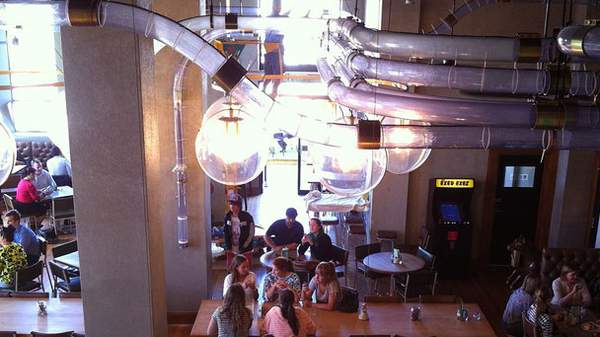Overview
Generally when you order a burger, it doesn't come flying to you at 100km an hour. The thought of that doesn't actually sound very fun or delicious; it sounds a lot like copping a pickle to the eyeball. But at Christchurch's C1 Espresso, high-speed sliders are a reality that doesn't hurt or impede your vision, thanks to an impressive overhead air suction system that delivers your chow straight from the kitchen to your table via pneumatic tube.
It's the future, as owner Sam Crofskey puts it. And there is something very Fifth Element about food travelling through clear plastic tubes to get to your mouth, but this system is actually more in tune with the past than the future. Originally operating as a bank — and taken over by C1 after their previous site was destroyed in the February 2011 earthquake — the High Street building was already fitted with old-school pneumatic tubes. After using the vacuum-like system to transport handwritten orders to the kitchen, the next step, naturally, was to stick food up there and see what happened.
With the existing tubes not quite big enough for edibles, new, slider-sized ones had to be fitted. They run from the kitchen and along the ceiling before dropping down to arrive at tables that sit up against the walls (and there's even talk of expanding delivery to outside tables through underground tubes). This means the cafe is always whirring, moving and buzzing; people's eyes flicker as they see a cylinder fly past up above and then grin in delight when said cylinder arrives at their table, holding three sliders and piping hot curly fries.
"We just thought it was very Willy Wonka or something, and we had to do it," says Crofskey. "It was really important that when people talked about us after the earthquake, that they connected with us in the same kind of way as before ... We had to make sure that people would make the effort to come back."
And with most of the city shut down — particularly when they initially reopened in November 2012 — C1 didn't just need a novelty; they needed to do something unique that fit in with their already-established brand and the community. Pioneering the second wave coffee movement since their beginnings in 1996 (back when no one knew what a barista was, according to Crofskey), C1 has always been known for great coffee and breakfast and details like their customised sugar packets that look like crayons and the sparkling water on tap from an old sewing machine. The pneumatic burgers and the decision to open for dinner are another extension of the C1 culture, and a good reflection of Crofskey's approach to hospitality.
"We had a chance to reinvent ourselves and, when we reopened, we were deciding who we wanted to be," says Sam. "We didn't want to deviate from our brand — it's still warm and inviting, and a place for the community to come together."
But offering breakfast, lunch and dinner isn't the only thing on Crofskey's agenda. Along with the cafe, he also works with a Samoan community to create a sustainable coffee industry in partnership with Women in Business, he bottles and sells OK! fruit nectars that also originate from the region, and he produces his own honey from the building's rooftop beehive and garden. And, with the cafe sharing real estate with a video store, art house cinema and, temporarily, the Christchurch Art Gallery, the space is so much more than somewhere to eat.
"We had this idea that we wanted to have this space that people could get lost in for a while, so you can go here and go to the movies, come out and go to the art gallery," says Crofskey.
And with plans to turn the upper levels into a boutique hotel, C1 will be like an island for the people of Christchurch. One where the room service is delivered at 100km an hour, of course.
